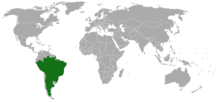Anadenanthera colubrina
| Anadenanthera colubrina | |
|---|---|

| |
| Scientific classification | |
| Kingdom: | Plantae |
| Clade: | Tracheophytes |
| Clade: | Angiosperms |
| Clade: | Eudicots |
| Clade: | Rosids |
| Order: | Fabales |
| Family: | Fabaceae |
| Subfamily: | Caesalpinioideae |
| Clade: | Mimosoid clade |
| Genus: | Anadenanthera |
| Species: | A. colubrina
|
| Binomial name | |
| Anadenanthera colubrina (
Vell.) Brenan | |

| |
| Range of Anadenanthera colubrina | |
| Synonyms | |
| |
Anadenanthera colubrina (also known as vilca, huilco, huilca, wilco, willka, curupay, curupau, cebil, or angico) is a
Nomenclature
Anadenanthera colubrina is known by many names throughout South America. In Peru it is known as willka (also spelled wilca, vilca and huilca) which in the Quechua languages means "sacred".
Geography
A. colubrina is found in Argentina, Bolivia, Brazil, Ecuador, Paraguay, Peru, Cuba, and Mauritius.[4]
Natural growing conditions

A. colubrina grows at altitudes of about 315–2,200 m (1,033–7,218 ft) with roughly 25–60 cm (9.8–23.6 in) per year of precipitation and a
General uses

Food
A sweetened drink is made from the bark.[1]
Gum
Gum from the tree can be used in the same way as gum arabic.[7]
Tannin
A. colubrina's tannin is used in industry to process animal hides.[1]
Entheogen
The beans of A. colubrina are used to make a snuff called vilca (sometimes called cebil). The bean pods are roasted to facilitate removal of the husk, followed by grinding with a
It is also believed that the ground beans were used as a snuff by the
Between 2013 and 2017,
Traditional medicine


The tree's bark is the most common part used medicinally.
Wood

In northeastern
Chemical compounds
Chemical compounds contained in A. colubrina include:
- 2,9-dimethyltryptoline – plant[13]
- 2-methyltryptoline – plant[13]
- 5-MeO-DMT – bark[13]
- 5-Methoxy-N-methyltryptamine – bark[13]
- Bufotenin – plant[13] beans[14]
- Bufotenin-oxide – fruit,[13] beans[14]
- Catechol – plant[13]
- Leucoanthocyanin – plant[13]
- Leucopelargonidol – plant[13]
- DMT-oxide – fruit[13][16]
- Methyltryptamine – bark[13]
- Orientin – leaf[13]
- Saponarentin – leaf[13]
- Viterine – leaf[13]
The bark and leaves contain tannin and the beans contain saponin.[12]
Botanical varieties
- Anadenanthera colubrina (Vell.Conc.)Brenan var. cebil (Griseb.)Altschul
- Anadenanthera colubrina (Vell.Conc.)Brenan var. colubrina
See also
References
References
- ^ PMID 16420708.
- ^ Diccionarios Botánicos Archived October 20, 2007, at the Wayback Machine
- ^ Angelo Z, Dante and Capriles, José M. La Importancia de las Plantas Psicotrópicas para la Economía de Intercambio y Relaciones de Interacción en el Altiplano sur Andino. Chungará (Arica). Volumen Especial, 2004. Pages 1023-1035. Chungara, Revista de Antropología Chilena. ISSN 0717-7356.
- ^ ILDIS LegumeWeb
- ^ a b Desiccation and storage of Anadenanthera colubrina beans. Archived July 16, 2006, at the Wayback Machine International Plant Genetic Resources Institute (IPGRI). Edilberto Rojas Espinoza.
- ^ Ethnobotanica.org Anadenanthera spp. Archived September 30, 2007, at the Wayback Machine
- ISBN 9780789026422.
- S2CID 5877023.
- ^ Hallucinogens Found in Mummy Hair
- ISBN 1-888755-02-4.
- S2CID 246999684.
- ^ a b Plantamed (Portuguese)
- ^ a b c d e f g h i j k l m n o Dr. Duke's Archived February 19, 2013, at the Wayback Machine Phytochemical and Ethnobotanical Databases
- ^ a b c UNO[permanent dead link]
- ^ Medicina traditional Ergebnisse einethnomedizinischen ...(German) Archived February 5, 2012, at the Wayback Machine
- ISBN 0-914171-51-8.
Further reading
- Rätsch, Christian; ISBN 0-89281-979-0.
- Pachter IJ, Zacharias DE, Ribeiro O (1959). "Indole Alkaloids of Acer saccharinum (the Silver Maple), Dictyloma incanescens, Piptadenia columbrina, and Mimosa hostilis". J. Org. Chem. 24 (9): 1285–1287. .
External links
- Anadenanthera colubrina Specimens Click View Med at the Field Museum
- Anadenanthera colubrina photo
- Anadenanthera colubrina (in Portuguese)
